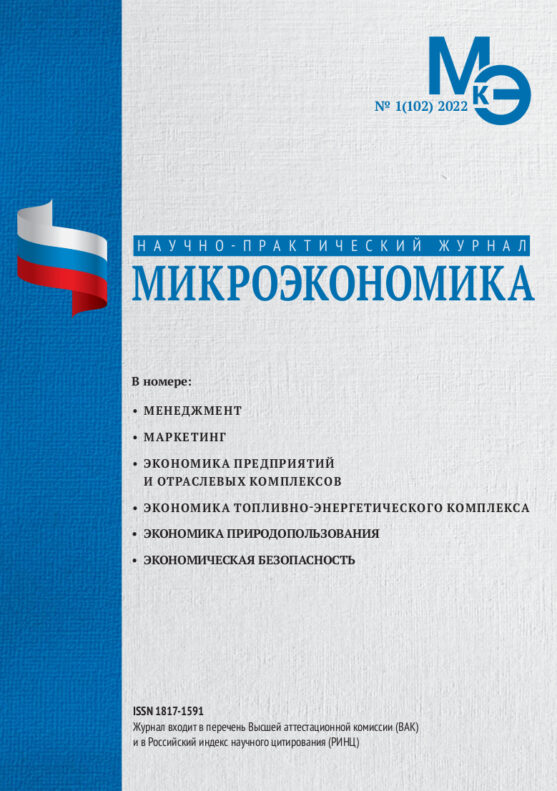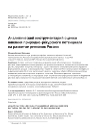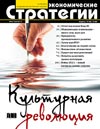Economic Strategies in the Extractive Sector of the Economy: Approaches, Methods and Results
DOI: 10.33917/es-3.189.2023.16-23
Economic-legal relations in organizing extraction and turnover of minerals was studied, typical economic strategies for organizations of the extractive sector of the economy were identified, effectiveness of implementing the portfolio strategies in the largest coal mining companies of Russia was shown, assessment of investments in the strategic innovation portfolio of an organization of the extractive sector of the Russian economy was proposed.
References:
1. Artov A.M., Laperdina T.G., Strizhova T.A., Khotuleva M.V., Chechetkin V.A., Perfil’eva E.V. Instrumenty strategicheskoi ekologicheskoi otsenki dlya planirovaniya razvitiya gornodobyvayushchei promyshlennosti v Rossii [Strategic Environmental Assessment Tools for Planning the Development of the Mining Industry in Russia]. Metodich. posobie. Moscow, Novokuznetsk, 2020, 132 p.
2. IM-EX.INFO. Informatsionno-analiticheskaya kompaniya [Sait], available at: http://imex.info/?_openstat=ZGlyZWN0LnlhbmRleC5ydTs2NTQ2OTY2MzsxMjQ3MDA2ODQxNzt5YW5kZXgucnU6cHJlbWl1bQ&yclid=6963604192633815039/
3. Petrenko I.E. Itogi raboty ugol’noi promyshlennosti Rossii za 2021 [The Results of the Work of the Coal Industry in Russia for 2021]. Ugol’, 2022, no 3, pp. 9–23.
4. OOO “El’gaugol” [Elgaugol LLC]. Integrum. Proverka kontragenta, available at: https://contragent.integrum.ru/ul/accounting/7550562.
5. Stolbova N.F., Isaeva E.R. Petrologiya uglei [Petrology of Coals]. Ucheb. Posobie. Tomskii politekhnicheskii universitet, Tomsk, Izd-vo Tomskogo politekhnicheskogo un-ta, 2013, 77 p.
6. Kholodov V.N. Tipy katageneticheskikh transformatsii v stratisfere i osadochnye poleznye iskopaemye [Types of Catagenetic Transformations in the Stratisphere and Sedimentary Minerals]. Uchenye zapiski Kazanskogo universiteta, vol. 153, book 4. Kazan’, 2011, pp. 16–53.
7. Perechen’ investitsionnykh proektov, napravlennykh na realizatsiyu Programmy razvitiya ugol’noi promyshlennosti Rossii na period do 2035 goda. Prilozhenie 8 [List of Investment Projects Aimed at Implementing the Russian Coal Industry Development Program for the Period up to 2035. Appendix No. 8.]. Normativnye i sudebnye akty RF, available at: https://sudact.ru/law/rasporiazhenie-pravitelstva-rf-ot-13062020-n-1582-r/programma-razvitiia-ugolnoipromyshlennosti-
rossii/prilozhenie-n-8/
8. Ermakova N.M. Privlechenie inostrannykh investitsii v neftegazodobyvayushchuyu promyshlennost’ Rossiiskoi Federatsii [Attracting Foreign Investment in the Oil and Gas Industry of the Russian Federation]. Problemy rynochnoi ekonomiki, 2019, no 1, pp. 37–43.
9. Sirotkin S.A., Kel’chevskaya N.R. Ekonomicheskaya otsenka investitsionnykh proektov: Ucheb. dlya studentov vuzov, obuchayushchikhsya po spetsial’nosti “Ekonomika i upravlenie na predpriyatiyakh (po otraslyam)” [Economic Evaluation of Investment Projects: a Textbook for University Students Studying in the Specialty “Economics and Management at Enterprises (by industry)”]. 3-e izd., pererab. i dop. Moscow, Yuniti-Dana, 2011, 311 p.






